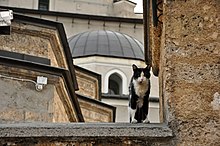


The cat is considered "the quintessential pet" by Muslims,[1] and is admired for its cleanliness, and was a beloved animal to Muhammad.[2] Unlike many other animals, such as dogs, Islamic Law considers cats ritually pure and possess baraka (blissful energy),[3] and allows cats to freely enter homes and even mosques. Although cats are ritually pure, their flesh is forbidden.[3] Cats are believed to be the most common pet in Muslim countries.[1]

The American poet and travel author Bayard Taylor (1825–1878) was astonished when he discovered a Syrian hospital where cats roamed freely. The institution, in which domestic felines were sheltered and nourished, was funded by a waqf, along with caretakers' wages, veterinary care, and cat food. Edward William Lane (1801–1876), a British Orientalist who resided in Cairo, described a cat garden originally endowed by the 13th-century Egyptian sultan Baibars.[1]
Wilfred Thesiger, in his book The Marsh Arabs, notes that cats were allowed free entry to community buildings in villages in the Mesopotamian Marshes and were even fed.[4][page needed] Aside from protecting granaries and food stores from pests, cats were valued by the paper-based Arab-Islamic cultures for preying on mice that destroyed books. For that reason, cats are often depicted in paintings alongside Islamic scholars and bibliophiles.
In Islamic tradition, cats are admired for their cleanliness. They are considered to be ritually clean, and are thus allowed to enter homes[1] and even mosques, including Masjid al-Haram. Food sampled by cats is considered halal, in the sense that their consumption of the food does not make it impermissible for Muslims to eat, and water from which cats have drunk is permitted for wudu (the ablution that is done by Muslims).[1] Furthermore, there is a belief among some Muslims that cats seek out people who are praying.[5]
Muslim scholars are divided on the issue of neutering animals. Most, however, maintain that neutering cats is allowed "if there is some benefit in neutering the cat and if that will not cause its death".[6] Muhammad ibn al Uthaymeen, a 20th-century Saudi Arabian Wahhabi imam, preached:
If there are too many cats and they are a nuisance, and if the operation will not harm them, then there is nothing wrong with it, because this is better than killing them after they have been created. But if the cats are ordinary cats and are not causing a nuisance, perhaps it is better to leave them alone to reproduce.[6]
Many Muslims believe that Muezza (orMuʿizza; Arabic: معزة) was Muhammad's favourite cat,[2][7] however, there is no mention of any such cat in the hadith or supplementary works,[8] which leads many Muslims to argue that this cat may not have existed.[9]
Whether Muezza existed or not, Muhammad is known to have criticized abusers of cats.[10] By one account, Muhammad awoke one day to the sounds of the adhan. Preparing to attend prayer, he began to dress himself; he soon discovered his cat Muezza sleeping on the sleeve of his prayer robe. Rather than wake her, he used a pair of scissors to cut the sleeve off, leaving the cat undisturbed. There is a similar story attributed to Sheikh al-Arif Ahmad al-Rifa’i (died 1182/1183) according to Al-Dhahabi, although the cat has no name in this account.[9]
In still another charming legend about the Prophet, one day his favorite cat Muezza bowed to thank him for some kind favor and, by this story, Muhammad then passed his hand down three times the length of the animal's back, giving to it—and to all cats evermore—the enviable capacity always to land squarely on their feet.
Stories of cats who seek out persons who are praying, and of cats sensitive to the presence of grace, are common.
عُذِّبَتِ امْرَأَةٌ في هِرَّةٍ سَجَنَتْها حتَّى ماتَتْ، فَدَخَلَتْ فيها النَّارَ، لا هي أطْعَمَتْها ولا سَقَتْها، إذْ حَبَسَتْها، ولا هي تَرَكَتْها تَأْكُلُ مِن خَشاشِ الأرْضِ